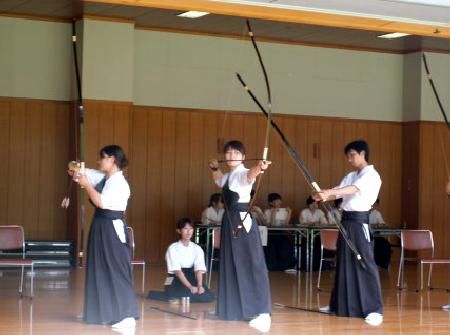
Figure 1.--Here we see Japanese highschool students practicing Kyudo. Mostly boys are interested, but several girls at this school in 2005 also participated.


Figure 1.--Here we see Japanese highschool students practicing Kyudo. Mostly boys are interested, but several girls at this school in 2005 also participated. |
Kyudo is essentially Japanese archery, but as with the other martial arts there is more involved than just the sport. The character 'kyu" means bow. The character "do" means way or path. Thus kyudo means the "way of the bow". Some Japan sources see kyudo as the purest of all the martial ways. Archery has been used for hunting, war, court ceremonies, games, and various contests.
Japanese archery was once known as kyujutsu (bow technique) which include both skills and techniques of military archery. There are still ancient kyudo schools which were called ryu. Kyudo ceremonies and games continue. Interestingly kyudo (archery) in the first half of the 20th century, kyudo does not seem to have had the same status as the kendo. At least as far as we can tell the Japanese militarists who seized control of Japan in the inter-War era seem more interested in swords than bows. Modern kyudo is practiced primarily as a method of physical, moral, and spiritual development.
Kyudo is essentially Japanese archery, but as with the other martial arts there is more involved than just the sport. The character 'kyu" means bow. The character "do" means way or path. Thus kyudo means the "way of the bow". Some Japan sources see kyudo as the purest of all the martial ways. There is also Kyujutsu which is archery contestancs persued as royal court games.
Kyudo besides archery skills is seen as the pursuit of truth, goodness, and beauty.
The practioner of Kyudo is sees shooting as truth which is pure and right-minded. There are three elements (attitude, movement, and technique), all of which combine in a condition of perfect harmony. For the Kyudo practioner, the perfect shot is not meerly one which strikes the center of the target, but a shot in which the arrow can be visualized in the target before release by the bowman.
Goodness in Hyudo include qualities like courtesy, compassion, morality, and non-aggression. A Kyudo practioner can exhibit goodness by his attitudes and everyday behavior. is shown by displaying proper attitude and behavior in all situations. This is reflected in archery skills allowing an archer to main composure and grace even when under stress or involved in conflict.
Beauty is seen as enhancing life as well as stimulating the spirit. The Kyudo practioner sees truth and goodness as beautiful. Beauty in Kyudo is not only perfection of technique, but also the elaborate etiquette involved in the Kyudo ceremony. The etiquette is formal and can be seen as superflulous ritual but in essence is simple common courtesy and respect or other practioners. Other aspects of beauty include the esquisitly fashioned bow and the practioner's traditional costume.
Archery has been used for hunting, war, court ceremonies, games, and various contests. Japanese archery was once known as kyujutsu (bow technique) which include both skills and techniques of military archery.
There are still ancient kyudo schools which were called ryu.
Japanese Samuri have practiced archery as a form of combat for centuries. Just when the bow was first intoduced I do not know, but the Japanese were using archers to combat the Mongol invasions of the 13th century. Likewise the early history of Kyudo is not well understood. The world Kyudo appears anout the late 19th century after the Menjo Restoration. We suspect that it was in part a reaction to Japan's modernization and an attemp to preserve older traditions.
Kyudo ceremonies and games continue. Interestingly kyudo (archery) in the first half of the 20th century, kyudo does not seem to have had the same status as the kendo. At least as far as we can tell the Japanese militarists who seized control of Japan in the inter-War era seem more interested in swords than bows.
Modern kyudo is practiced primarily as a method of physical, moral, and spiritual development.
Kyudo like the other martial arts include not only skills but philosophical and religious elements. Japan's religious heritage, especially (Buddhism and Shintoism) have influenced Kyudo. Zen Buddhism which evolved in China is an important of Japan's moder religios heritage. Japan's native religion is Shintoism which until the country defeat in World war II was the state religion. Other religions scuch as Christianity were supressed, but Buddhism and Shintoism while not merging seemed to have complemented each other in the Japanese miknd. As a result, both have influenced Kyudo. Some practioners see the ritual of the archer in using the bow and handling the arrows as well as the costume as basically Shinto and practiced for more than 2,000 years. Zen has come to influence Kyudo somewhat more recently as Buddhism arrived in Japan more recently. Archers in the Kamakura Period (1185-1333) came to accept Zen as an approach for moral training.
Zen appears to have become even more important in the 17th and 18th cednturies when a period of relative peace during which philosophy became more important as the actual employment of archers in battle declined somewhat importance.
Here we see Japanese highschool students practicing Kyudo (figure 1). Mostly boys are interested, but several girls at this school in 2005 also participated. We assume that this is a fairly recent development.
Navigate the Boys' Historical Clothing Web Site:
[Return to the Main martil arts discipline page]
[Return to the Main martial arts page]
[Introduction]
[Activities]
[Biographies]
[Chronology]
[Cloth and textiles]
[Clothing styles]
[Countries]
[Topics]
[Bibliographies]
[Contributions]
[FAQs]
[Glossaries]
[Satellite sites]
[Tools]
[Boys' Clothing Home]
